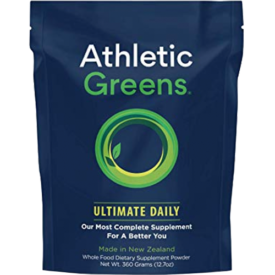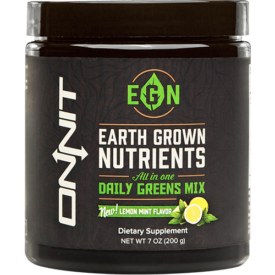In the world of supplements there are two big names that are best known for their focus on earth-grown nutrients: Athletic Greens and Onnit.
Outside of their very refined marketing techniques they both partner with powerful marketers to spread their name, their green superfood powders also have a lot in common: they both have a hit of organic what grass and barley grass, they’ve got the famous “liver support” herb milk thistle (it’s usually what makes products call themselves “detoxers”), they both have a focus on gut health.

Extraordinarily nutritious greens powder with many potential health benefits. Also one of the best-tasting greens powders on the market.

Since they’re both at the top of the supplement food chain. I decided to compare them: Does Athletic Greens or Onnit’s Earth Grown Nutrients All in One Daily Greens Mix come out on top?
Ingredients
Onnit: There are around twenty-five ingredients split into five categories that are intended to alkalize, provide antioxidants, detox, improve digestion, and a fifth “Rainbow Blend” of fruits and vegetables that are meant to provide “numerous health benefits” and “delicious natural flavoring.” These ingredients include wheat grass, oat grass, algae, milk thistle, broccoli sprout, and Jerusalem artichoke, all of which are organic.
There is no information as to how many antioxidants it contains relative to a serving of fruits or vegetables and it doesn’t appear to contain probiotic bacteria, though it is a source of prebiotics, which act as food for probiotics.
Athletic Greens: With seventy-five ingredients, Athletic Greens contains a wider variety of greens than I’ve seen in any other greens powder. Standouts include spirulina, rhodiola rosea, and more than seven billion probiotic bacteria, which is more than many dedicated gut health supplements.
It’s worth emphasizing here that both products contain proprietary blends, which is always a little frustrating: I want to know how much of each ingredient it contains so I can determine if it contains an effective dose.
However, Athletic Greens has far, far more ingredients, plus it has probiotic bacteria and it has a lot of adaptogens too, which I’ll discuss in the sections below.
Winner: Athletic Greens
Taste
Onnit: Pleasantly bland, I tried the “lemon mint flavor” and it tastes a lot like a mixture of chamomile and green tea, with a very mild hint of lemon. It’s not too bitter and it’s better than most greens powders. If you like green tea, you’ll like this.
Athletic Greens: Greens powders are famously gross and while Onnit’s is surprisingly easy to stomach, Athletic Greens is the only one that I’ve ever actually enjoyed. Vaguely tropical with hints of papaya, vanilla, and carrot, the wisest addition to the flavor is ginger, which does a great job of working with the bitterness of greens instead of trying to smother it with sweetness like a lot of powders. I actually like sipping this stuff.
Winner: Athletic Greens
Price
Onnit: Coming in at between $35 and $45 for a tub of 15 servings, this comes to about $2 to $2.50 for a scoop.
Athletic Greens: It’s best to get monthly subscriptions of Athletic Greens, which brings the price down to somewhere between $65 and $75 for a bag of 30 servings, or $2.30-ish per scoop. If you get a one-off order the price is closer to $3.30 per scoop. They have a money back guarantee as well, so you’re not risking all that much here.
So Onnit is cheaper as a one-off purchase but Athletic Greens is cheaper if you sign up for a monthly shipment.
Winner: Onnit
Effectiveness
Onnit: First of all, a lot of folks like to say that greens powders don’t have any value but there are indeed studies, published in the Journal of Chiropractic Medicine, that have found taking a daily greens supplement can lower your blood pressure.(1)(2) The individual ingredients have also been linked to a variety of effects, like the algaes popular in these products have links with lower risks of heart disease and fatty liver disease, according to the Journal of Medicinal Food.(3)
But these products aren’t always great sources of vitamins and minerals. Onnit’s only contains about 35 percent of your daily Vitamin C, 22 percent of your iron, 12 percent of your fiber, 6 percent of your calcium… that’s about all.
It doesn’t say anything about minerals like magnesium, which a lot of people get from leafy greens, and that’s important since it implies that it can supplement some of your green vegetable intake. It doesn’t say if it “alkalizes” as well as a serving of fruits or vegetables, it doesn’t say if it has more or less antioxidants than a cup of, well, anything.
I did like the addition of digestive enzymes and prebiotic bacteria, which may help with digestive health. But even in this category, Athletic Greens wins out.
Athletic Greens: First of all, the nutrition label is expansive and comprehensive: 700 percent of your Vitamin C, about 100 percent of most B-vitamins, 80 percent of Vitamin A, over 300 percent of your Vitamin E. Besides a giant hit of zinc and 35 percent of your selenium — which both could impact testosterone levels, according to data published by Nutrition. — it’s not all that high in minerals.(4) But it’s still higher in minerals than Onnit.
It’s also got over 7 billion probiotic bacteria, regular consumption of which has been linked to better immunity and body composition.(5)(6) On top of that it has a lot more adaptogens like reishi, which might help the body to manage the effects of stress. Simply put, there are more ingredients and more diverse effects in Athletic Greens.
Winner: Athletic Greens
The Overall Winner: Athletic Greens
At the end of the day, Onnit gets props for being slightly cheaper, but Athletic Greens simply contains more nutrition. It has 7 billion probiotics, Onnit doesn’t appear to have any. It has a variety of adaptogens, Onnit doesn’t have any. It has way, way more vitamins and minerals. And it’s a lot tastier.
This wasn’t super hard to decide: We think Athletic Greens is a better supplement.
References
1. Zhang, J. et al. Taking nutritional supplements for three months reduced blood pressure but not blood lipid levels in students. J Chiropr Med. 2006 Summer;5(2):53-9.
2. Zhang J, et al. The effect of fruit and vegetable powder mix on hypertensive subjects: a pilot study. J Chiropr Med. 2009 Sep;8(3):101-6.
3. Ku CS, et al. Health benefits of blue-green algae: prevention of cardiovascular disease and nonalcoholic fatty liver disease. J Med Food. 2013 Feb;16(2):103-11.
4. Prasad AS, et al. Zinc status and serum testosterone levels of healthy adults. Nutrition. 1996 May;12(5):344-8.
5. Bäckhed, F. et al. The gut microbiota as an environmental factor that regulates fat storage. Proc Natl Acad Sci U S A. 2004 Nov 2;101(44):15718-23.
6. Kadooka, Y. et al. Regulation of abdominal adiposity by probiotics (Lactobacillus gasseri SBT2055) in adults with obese tendencies in a randomized controlled trial. Eur J Clin Nutr. 2010 Jun;64(6):636-43.
